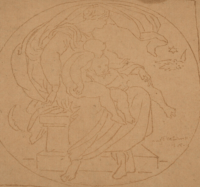Johannes NIESSEN
Johannes Niessen (born August 27, 1821, in Cologne; died August 23, 1910, there) was a German history painter of the Düsseldorf School. Niessen was a student at the Düsseldorf Academy of Arts from 1843 to 1847, where he studied under Eduard Risse, Karl Ferdinand Sohn, and Joseph von Keller. In 1846, he gained recognition with his work “Disowning of Cordelia” (after Shakespeare’s “King Lear”), which, along with the soon-to-follow “Herodias with the Head of John the Baptist,” raised high expectations regarding color.
After a brief stay in Paris, where he copied Titian’s “Entombment of Christ” at the Louvre—an effort showcasing a profound understanding of Titian’s color—he traveled to Venice in 1847 to create a copy of Titian’s famous “Assumption of the Virgin” for the Düsseldorf Academy.
From Venice, Niessen moved to Florence and Rome, returning to Düsseldorf in 1850 with extensive studies, where he painted various historical works. He was a member of the artists’ association Malkasten from 1855 to 1858. In 1859, he moved to Weimar, where he established and led a life drawing studio at the art school. However, in 1866, he settled in Cologne, where he served as a professor and director of the Wallraf-Richartz Museum, significantly contributing to its arrangement and cataloging.
Niessen was also a member of the Vienna Academy. For over 25 years, he provided free art lessons to talented but impoverished students. In his sixtieth year, the Catholic Niessen married Emma Bensiek, twelve years his junior, who came from a Hamburg merchant family. In his seventieth year, he began a friendship with Ludwig Schneller, the then Protestant pastor in Cologne, with whom he maintained an active exchange regarding the content of the Bible.
Showing all 4 resultsSorted by latest
-
Entwurf/Studie | Zeichnung von Johannes NIESSEN (4/4)
Johannes NIESSEN (1821-1910)
Aus Kunstammlung Kasimir Hagen Koeln -
Entwurf/Studie | Zeichnung von Johannes NIESSEN (3/4)
Johannes NIESSEN (1821-1910)
Aus Kunstammlung Kasimir Hagen Koeln -
Entwurf/Studie | Zeichnung von Johannes NIESSEN (2/4)
Johannes NIESSEN (1821-1910)
Aus Kunstammlung Kasimir Hagen Koeln -
Entwurf/Studie | Zeichnung von Johannes NIESSEN (1/4)
Johannes NIESSEN (1821-1910)
Aus Kunstammlung Kasimir Hagen Koeln




